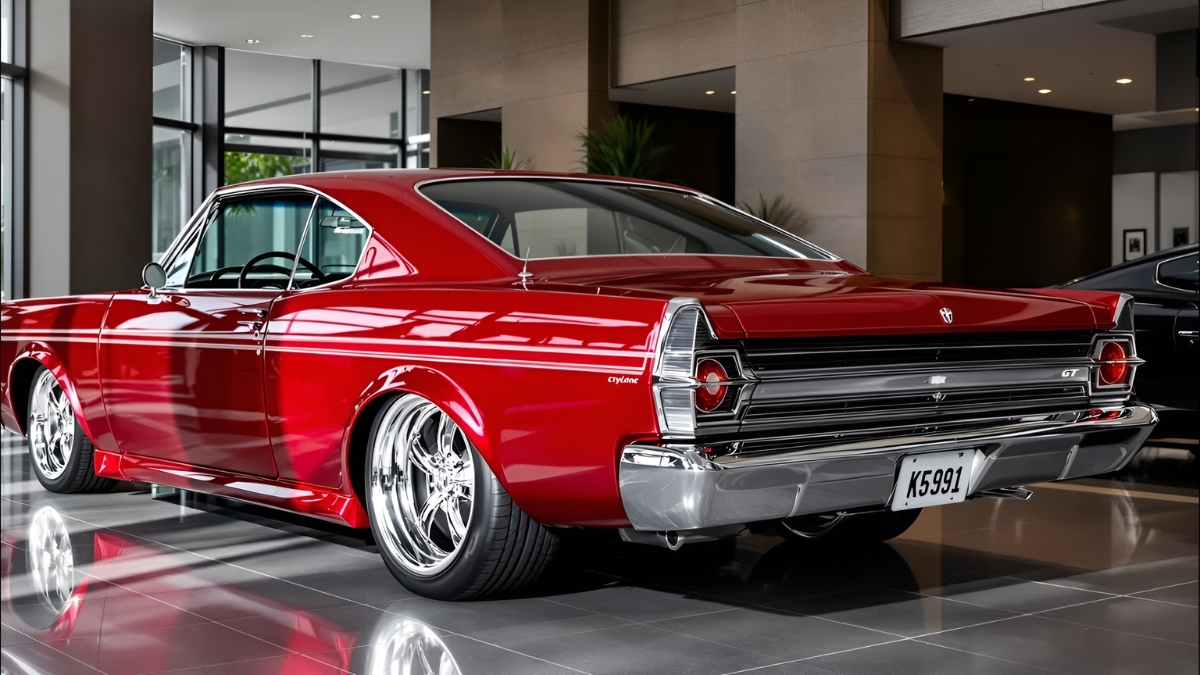When you think of American muscle cars from the 1960s, names like Mustang, GTO, and Camaro often come to mind. But there’s a hidden gem that deserves equal recognition: the 1966 Comet Cyclone GT. With its sleek design, impressive performance, and timeless style, it can hold its own against more famous muscle cars.
What Exactly Is the 1966 Comet Cyclone GT?
The 1966 Comet Cyclone GT was Mercury’s answer to the muscle car craze sweeping America. It was essentially a high-performance version of the Comet, featuring aggressive styling, upgraded suspension, and powerful V8 engines.
It wasn’t just about speed; the Cyclone GT combined performance with refinement. From its dual exhausts to its sporty interior, it was built for those who wanted both muscle and sophistication in one package.
What Is the Engine and Performance Like?
The Cyclone GT came with a range of engines, starting from a 289 cu in V8 producing around 200 hp, all the way up to the legendary 427 cu in V8, capable of 425 hp. That’s plenty of power for a car weighing just over 3,000 pounds.
0-60 mph times could dip under 6 seconds for the big-block versions, making it competitive with other muscle cars of the era. Coupled with a four-speed manual or three-speed automatic transmission, the Cyclone GT offered thrilling acceleration and precise handling.
How the 1966 Comet Cyclone GT Stands Out – Explained Simply
What set the Cyclone GT apart was more than just raw power. It featured unique styling cues like the blacked-out grille, hood scoop, and sporty stripes, which gave it an aggressive yet refined look.
Inside, it offered bucket seats, sporty gauges, and a driver-focused layout. This combination of aesthetics and performance made it a true muscle car in its own right, even if it didn’t get the same fame as some of its contemporaries.
When and Why the Cyclone GT Became a Muscle Car Contender
The Cyclone GT was introduced in 1964, but by 1966, it had become Mercury’s performance flagship. With more power, better suspension, and sporty trim options, it could compete with the best muscle cars on the market.
Why it matters: while the Comet base model was more of a compact sedan, the Cyclone GT proved Mercury could produce a serious high-performance car with speed, style, and handling that muscle car enthusiasts would appreciate.
Best Tips for Collectors or Owners
- Verify Engine Numbers: Original V8 engines, especially the 427 cu in, are highly collectible.
- Check Body and Frame: Rust is common in 1960s muscle cars, so inspect carefully.
- Preserve Original Features: Maintaining original trim, badges, and interior details helps retain value.
- Join Collector Communities: Clubs and forums can help with parts sourcing and restoration advice.
Quick Comparison: 1966 Cyclone GT vs Other Muscle Cars
| Feature | 1966 Comet Cyclone GT | 1966 Ford Mustang GT | 1966 Pontiac GTO | Notes |
|---|---|---|---|---|
| Engine Options | 289–427 V8 | 289–390 V8 | 389 V8 | Cyclone GT offered a large range of performance options |
| 0-60 mph | 6–8 sec | 7–9 sec | 6–8 sec | Big-block Cyclone GT was very competitive |
| Styling | Aggressive fastback, hood scoop | Sporty coupe | Muscle sedan | Cyclone GT had a unique Mercury flair |
| MSRP (1966) | ~$3,000–$3,500 | ~$2,800 | ~$3,200 | Slightly premium for high-performance trims |
Common Mistakes With 1966 Cyclone GT and How to Avoid Them
A common mistake is overpaying for a restored car without checking originality. Always verify engine, transmission, and trim numbers against factory records.
Another mistake is neglecting maintenance on high-performance engines. Classic V8s need routine care—oil changes, carb tuning, and brake checks—to remain reliable.
The Latest Updates in Collectibility
Today, the 1966 Comet Cyclone GT is increasingly recognized as a classic muscle car worth collecting. Prices vary based on engine size and condition:
- Small-block V8 models: $25,000–$40,000
- Big-block 427 versions: $80,000–$120,000+
Numbers-matching cars, rare color schemes, and well-preserved interiors are especially sought after by collectors.
Conclusion: Why the 1966 Comet Cyclone GT Remains a Muscle Car Legend
The 1966 Comet Cyclone GT proves that Mercury could compete with the best muscle cars of the 1960s. With its powerful engines, unique styling, and driver-focused features, it’s a car that still excites enthusiasts today.
For collectors, restorers, or anyone who loves classic speed and style, the Cyclone GT is a hidden gem that deserves its place in muscle car history.
FAQ: 1966 Comet Cyclone GT
Q: When was the 1966 Comet Cyclone GT first produced?
A: The Cyclone GT was introduced in 1964, with the 1966 model refining performance and styling.
Q: What engines were available in the 1966 Cyclone GT?
A: Engines ranged from a 289 cu in V8 producing 200 hp to a 427 cu in V8 with 425 hp.
Q: Why is the Cyclone GT considered a muscle car?
A: Its powerful V8s, sporty suspension, and aggressive styling qualify it as a true muscle car.
Q: How much is a 1966 Cyclone GT worth today?
A: Prices range from $25,000 for small-block models to $120,000+ for big-block, numbers-matching cars.
Q: Can I still find original 1966 Cyclone GTs?
A: Yes, through classic car auctions, private sellers, and collector networks, though they are rare.



